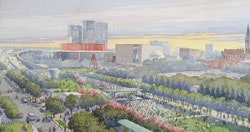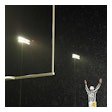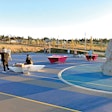An iconic urban park is taking shape atop a sun belt freeway.
 Rendering of a park to be built on a deck structure above Dallas' Woodall Rodgers Freeway
Rendering of a park to be built on a deck structure above Dallas' Woodall Rodgers FreewayTwenty-five years elapsed between the Texas State Department of Transportation's approval of Dallas' Woodall Rodgers Freeway and its first traffic in 1983. During that time, disagreements over the design of the 1.6-mile, east-west corridor - which marks the north end of Dallas's central loop, connects two Interstate highways and effectively separates the downtown district from the uptown district - caused much of the holdup. One camp wanted the eight-lane freeway to be elevated, while the other wanted it built below grade, allowing streets to bisect it overhead.
The latter camp eventually won out, making possible - albeit more than half a century after the freeway's initial approval - the construction of one of the most structurally creative and ambitious urban parks projects in history.
"It was a good bit of foresight," explains Willis Winters, assistant director of the city's parks and recreation department. "This section of the freeway was deliberately depressed below grade, so that at some point in the future something could be built on top of it."
That something is a 5.2-acre, amenity-filled park spanning three city blocks that will be built on a deck structure above the freeway. Winters, for one, a longtime parks and recreation advocate whom the Dallas Morning News earlier this year described as the "gentleman architect" of the Dallas Park and Recreation Department, has never seen a park plan like it. Although Phoenix and Richmond, Va., are among the small handful of municipalities that have parks built atop highway tunnels, none are as developed - in terms of landscaping, structural elements and programming - as will be the Woodall Rodgers deck park when it opens in approximately two years. Says Winters, "We looked long and hard, and we didn't find any facility quite like this. There's really nothing comparable."
Structurally, it may well be unique, but that doesn't mean Dallas parks and rec representatives didn't draw other comparisons when planning the deck park. Winters and his colleagues toured several of the largest, most successful and most famous urban parks throughout the country (Chicago's Millennium Park and New York City's Bryant Park among them). They chose to visit newer or recently reclaimed and revitalized urban parks that have been credited with both cultural and economic revitalization, two goals of the deck park project since its inception.
In 2005, a local group of real estate professionals approached the city with $1.5 million and their vision for the deck park, which not coincidentally will border downtown's booming Dallas Arts District, featuring numerous museums, theaters and other cultural attractions. "They wanted to do a larger legacy project," explains Winters. "They were interested in the potential impact on real estate and redevelopment." Also at that time, the parks and recreation department was forming a master plan for Dallas parks. Envisioning 18 parks in total, the plan focused on four parks for immediate potential development, including the deck park. Thus, the $1.5 million in privately raised seed money, which provided a feasibility study that defined the structural requirements and yielded some preliminary designs, couldn't have come at a better time. Says Winters, "It was a very fortuitous series of events."
The real estate group then asked the parks and rec department to include $20 million for the project in its 2006 bond program, and offered to match it twice over ($20 million in state and federal funds, and $20 million in private funds) upon a successful referendum. Part of a massive, $1.35 billion bond proposal that included a whopping $343 million for parks and recreation infrastructure, the $20 million was overwhelmingly approved by voters, and the project was under way in earnest. "We don't turn down a good deal," Winters says. "We saw that there was a good chance of this project happening, but we knew that it could only happen with that kind of public-private partnership."
That partnership now includes an official development agreement with the Woodall Rodgers Park Foundation, which, working in concert with the Real Estate Council, has been charged with fundraising and working with the city. The group also has pledged to fully operate and maintain the park - at an estimated annual expense of $2 million - for 99 years upon its opening, although the city will still own the park. "That's huge," Winters says. "It would be very difficult for a city department to take on that kind of budget increase, especially right now. We're very grateful that the foundation is filling that role for us."
Unfortunately, and as seems to be the case with large urban parks that develop over a period of years, the project's total cost has nearly doubled from the original $60 million. Winters contends that the now $110 million figure isn't the result of cost overruns, but rather of increases in the amount and scope of the park's numerous attractions.
Plans now call for a 15-foot-wide promenade replete with landscaping, shade structures and rest areas that serves as the primary pedestrian spine; a 6,000-square-foot botanical garden with granite pathways; a 15,000-square foot children's garden with numerous play areas and imaginative structures; an outdoor "reading and games room," a 2,600-square-foot courtyard that can be used for Dallas Public Library programs; an upscale restaurant with a glass facade and a dining veranda that connect it to the park's natural elements; a performance pavilion; numerous lawns and natural groves; a 3,200-square-foot pedestrian plaza; and a dog park.
Taking cues from more recent urban parks, and especially Millennium Park (which features the Crown Fountain and the Cloud Gate, known more commonly as "The Bean"), the deck park will likewise incorporate numerous iconic ornamental structures, the most impressive of which may be a tall fountain designed to be visible from the freeway below. Inspired by the form of a lily, the stacked-glass Icon Fountain will feature a reflecting pool, a "rain" feature and an interior cascade surrounded by a shallow splash pool.
"I think everyone here caught the fever from Millennium Park, and they could see what the impact on downtown Dallas could be," says Winters. "The scope has gotten bigger. I think everyone is envisioning things for the deck park that are much greater than what we were envisioning even six years ago."
Thankfully, the park foundation has already secured two separate $10 million state department of transportation grants and an additional $16.7 million this year in federal stimulus money. While fundraising continues, structural work on the freeway is already under way.
Economic development is likewise under way. Even before construction began, two large residential and commercial projects were expanded and reoriented to face the park rather than the freeway, which has been considered an eyesore. Says Winters, "We're already starting to see the development of a dense, compact area with a lot of entertainment options."
A quintessential sun belt city, Dallas is not exactly synonymous with urban density. But champions of the deck park believe it will help the city establish a true downtown identity. "We see this as the city's living room," says Winters, adding that numerous public meetings included not just downtown and uptown residents, but people throughout the metro area. "But this has never been a hard sell at all. I think the facility captures people's imaginations."
































